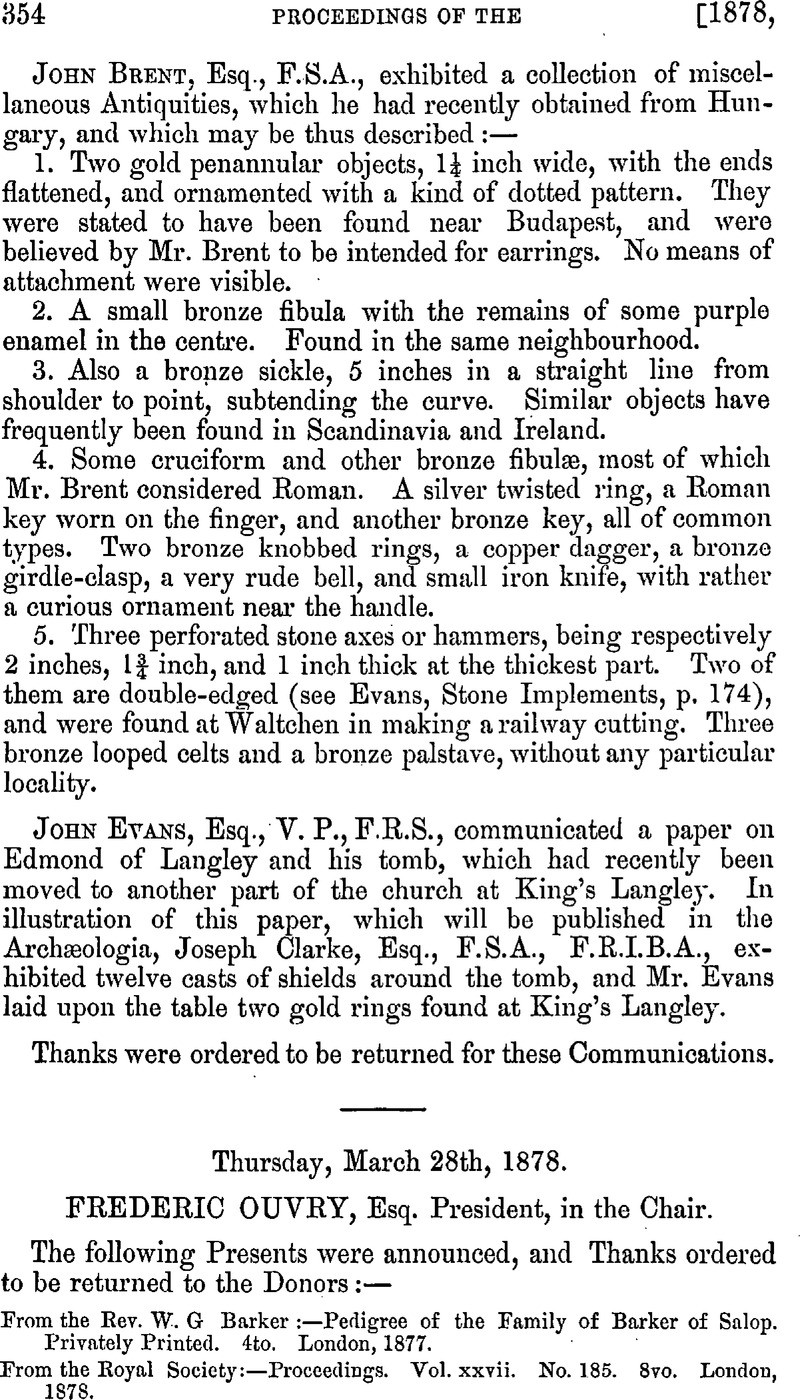No CrossRef data available.
Article contents
Thursday, March 28th, 1878
Published online by Cambridge University Press: 10 May 2010
Abstract

- Type
- Proceedings
- Information
- Copyright
- Copyright © The Society of Antiquaries of London 1878
References
page 355 note * See Grose, Antiquities of England, vol. ii.
page 361 note * Manning, Hist. Surrey, vol. ii. p. 563, says that it was given by Walter de Merton, but in the first of these deeds the name is clearly Norton.
page 362 note * Carshalton.
page 362 note † Gersume seems to have been a ready-money payment. On the word see Notes and Queries, vol. xi. ii. 81, 164, 431, 513, and xii. 93.
page 363 note * The manor of Kymersley or Kynnersley in Carshalton. 1 Eliz. John Scott held a capital messuage in Carshalton formerly Bartholomew Kynardesley's.—Lysons's Environs i. 125.
page 363 note † In 33 Edw. III. Sir R. Willoughby had licence to alienate the manor of Beddington to Nicholas Carrew, probably this person.
page 363 note ‡ Bergh, a manor in Banstead, the church of which was standing in Aubrey's time.
page 363 note § Richard Trewe appears as party to a deed in my possession of 36 Edw. III. relating to Woldingham ; he is there styled of Chelsham.
page 363 note ‖ Cuddington, a small parish near Banstead, destroyed to make room for Nonsuch. Sir Simon de Codyngton was knight of the shire for Surrey 25–45 Edw. III.
page 363 note ¶ Bures was a manor in Addington.
page 365 note * Spring corn is commonly called in Surrey “Lent corn.”—Warectum, Terra neglecta.—Ducange
page 365 note † There is a wood still so called.
page 365 note ‡ Such seems to be the meaning of this somewhat obscure passage. It appears as if the lessors made a certain allowance of cloth for the livery of the indoor servants.
page 366 note * The same word occurs in an inventory given by Manning under Merstham (Hist. Surrey, vol. ii. 255), but he does not attempt any explanation of it. Mr. J. E. Thorold Rogers, writing in Notes and Queries (5 s. x. 275) says, “The word ‘mariola’ almost certainly means a gander. I have frequently found it in mediæval accounts always as a subdivision of auca and contrasted with aucula.”
page 366 note † See Prompt. Parv. in, verbo.
page 366 note ‡ ? Whether for lagonem or lagenam, a gallon measure.
page 366 note § A lease granted 19 Richard III., 1396, by the Prior and Convent of Christ Church, Canterbury, to John atte Dene and others, of the manor of Merstham, given by Manning (History of Surrey, vol. ii. P. 255) is alike in so many points that I append a few extracts from it. Live stock—2 “sterts,” 8 “porc,” 5 “porcil,” 12 “porcel.” Geese, 2 aucas “mariol.” In the hall, 1 pelvim cum lavatorio, 2 dinner tables, of which one is fixed with a pair of tressels. In the kitchen, 1 pot containing 3 gallons (lagenas) ; 1 plough with all other fit apparatus. In the granary, 1 bushel. The Prior and Convent reserve to themselves all escheats, forfeitures, &c., require the lessees to find for the bailiff and his servants all their expenses twice in the year for one day and one night when he shall come to overlook the manor ; also for the steward of the lord, the Prior and Convent for holding courts. The tenants not to demise without leave of the lessors. To house all corn in the barns of the manor and to carry all dung upon the lands for compost. At the end of the term to deliver up all the goods before mentioned or the value of them.




